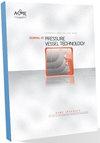承压管道轴表面缺陷极限载荷公式的目标模型误差确定
IF 1
4区 工程技术
Q4 ENGINEERING, MECHANICAL
Journal of Pressure Vessel Technology-Transactions of the Asme
Pub Date : 2022-07-15
DOI:10.1115/1.4055008
引用次数: 0
摘要
含有轴向矩形缺陷的承压球墨管残余强度的计算公式和标准已有数十种。它们的准确性通常以所谓的“模型误差”概念来表征。后者被建立为实验数据与计算结果的平均偏差。事实上,以这种方式确定的模型误差部分与所选实验数据的有效性和范围有关。我们的工作理念是引入“目标模型误差”的概念。期望仅用给定的尺寸比例来描述特定缺陷的给定公式的准确性,这被称为“兴趣点”。因此,每个实验都可以根据其在兴趣点上的权重给出目标模型误差的贡献。这些权重是根据为感兴趣点计算的无因次残余强度与考虑的实验的实际缺陷尺寸之间的差异主观建立的。在ASME、PPCORC和O-formula这三种著名公式中,缺陷深度与壁厚之比分别为0.5、0.6、0.7和0.8时,给出了确定目标模型误差的实例。本文章由计算机程序翻译,如有差异,请以英文原文为准。
Targeted Model Error Determination for Limit Load Formulas for Axial Surface Defect in a Pressurized Pipe
There are dozens of formulas in literature and standards for residual strength calculation of the pressurized ductile pipes with axial rectangular defect. Their accuracy is usually characterized by so called “model error” notion. The latter is established as the averaged deviance of experimental data from the calculated results. In fact, the determined in such way model error is partly related to the validity and range of the chosen experimental data. The idea of our work is to introduce the notion of “targeted model error”. It is expected to characterize the accuracy of given formula for the particular defect only with given ratio of its dimensions, which is named as the “point of interest”. So, every experiment can give the contribution to the targeted model error according to its weight on the point of interest. These weights are subjectively established based on the difference between the dimensionless residual strengths calculated for the point of interest and for the real defect dimensions of the considered experiment. Practical examples of determination of the targeted model errors are performed for the ratios of the defect depth to wall thickness equal to 0.5, 0.6, 0.7 and 0.8 for three well-known formulas - ASME, PPCORC and O-formula.
求助全文
通过发布文献求助,成功后即可免费获取论文全文。
去求助
来源期刊
CiteScore
2.10
自引率
10.00%
发文量
77
审稿时长
4.2 months
期刊介绍:
The Journal of Pressure Vessel Technology is the premier publication for the highest-quality research and interpretive reports on the design, analysis, materials, fabrication, construction, inspection, operation, and failure prevention of pressure vessels, piping, pipelines, power and heating boilers, heat exchangers, reaction vessels, pumps, valves, and other pressure and temperature-bearing components, as well as the nondestructive evaluation of critical components in mechanical engineering applications. Not only does the Journal cover all topics dealing with the design and analysis of pressure vessels, piping, and components, but it also contains discussions of their related codes and standards.
Applicable pressure technology areas of interest include: Dynamic and seismic analysis; Equipment qualification; Fabrication; Welding processes and integrity; Operation of vessels and piping; Fatigue and fracture prediction; Finite and boundary element methods; Fluid-structure interaction; High pressure engineering; Elevated temperature analysis and design; Inelastic analysis; Life extension; Lifeline earthquake engineering; PVP materials and their property databases; NDE; safety and reliability; Verification and qualification of software.

 求助内容:
求助内容: 应助结果提醒方式:
应助结果提醒方式:


